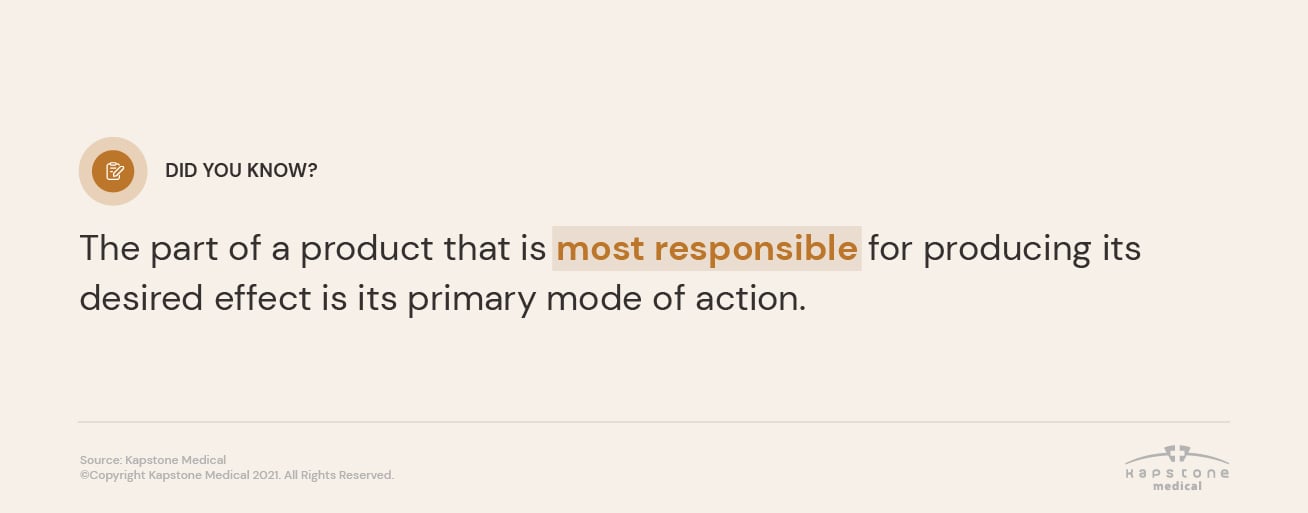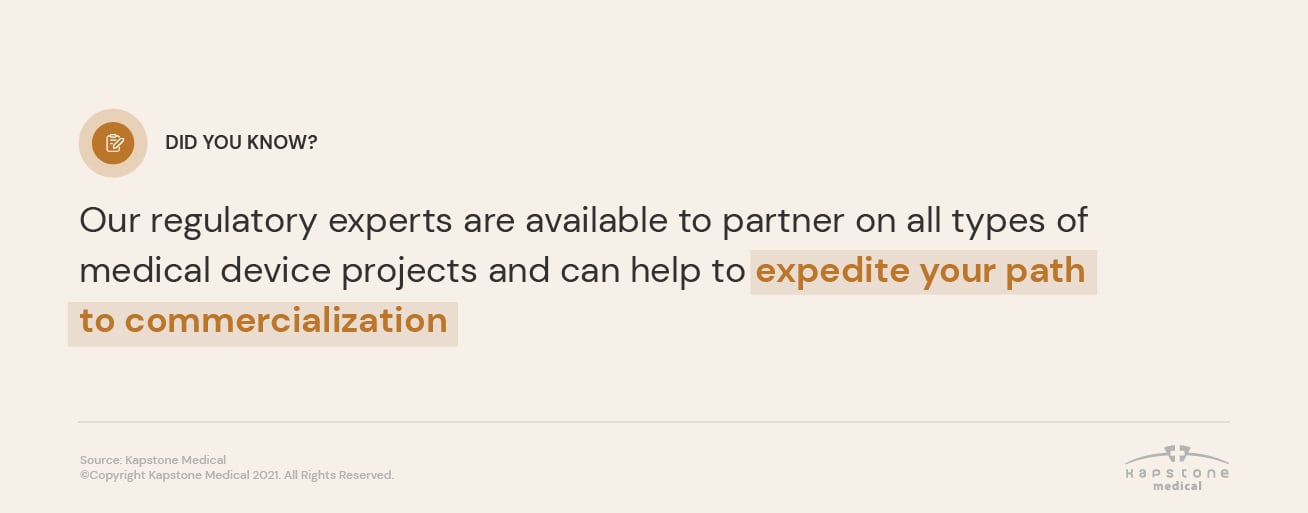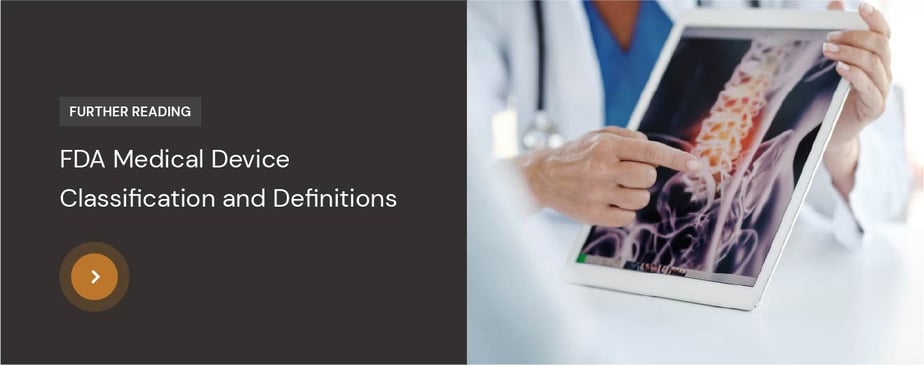When a medical device operates in combination with a drug or biologic, it is known as a combination product. Regulatory affairs is a complicated part of the development process for any one of those product types, but pursuing clearance or approval for a combination product presents a unique set of challenges.
One key concept drives regulatory affairs for combination products: primary mode of action, or PMOA. In this blog, we’ll define PMOA, explain how to determine your product’s PMOA, define combination products and give examples, and finally talk through some of the challenges that may arise in your path to commercialization in the United States.
As always, please feel free to reach out to the team at Kapstone Medical with any questions. Our regulatory experts are available to partner on all types of medical device projects and can help to expedite your path to commercialization.
PMOA Meaning and Importance
The FDA defines a product’s primary mode of action as a “single mode of action of a combination product that provides the most important therapeutic action of the product. The most important therapeutic action is the mode of action expected to make the greatest contribution to the overall intended therapeutic effects of the combination product.”

In other words, the part of a product that is most responsible for producing its desired effect is its primary mode of action. The desired effect is, naturally, the intended use of your product.
Your product’s PMOA will determine its path to FDA 510(k) clearance or premarket approval in the United States, including the FDA departments that will need to be a part of its review.
What Is a Combination Product?
The FDA defines a combination product as “a product composed of any combination of a drug and a device; a biological product and a device; a drug and a biological product; or a drug, device, and biological product.”
Determining FDA Primary Mode of Action
Now that we’ve covered the basic definition of PMOA and the types of products that are considered to be combination products, let’s talk through how to determine a combination product’s primary mode of action.
Step 1: Clearly identify your product’s intended use or impact
For the purposes of this exercise, let’s consider an imaginary cardiovascular implant product developed to stop the mitral valve from leaking. That is the product’s intended use.
Keep in mind that this product is imaginary and that our judgments and justifications as to its use and classification cannot be taken as instructive. Please consult with an expert or rely on FDA documentation to determine your combination’s product PMOA.
Step 2: Identify which components are directly responsible for that use or impact
Our imaginary product has two components: the implant itself and an interior that slowly releases a drug to control bleeding in the area of the mitral valve. Studies have shown that the use of this drug in combination with the implant has greater efficacy than the implant alone.
However, think back to the product’s intended use: to stop the mitral valve from leaking. The implant alone can accomplish that outcome; the drug is just an advisable add-on for patients who need extra bleeding control. In this case, the implant (or device) would likely be considered the product’s PMOA.

A good question to ask yourself when working through this exercise is what component(s) could be removed such that the device would still perform its intended purpose?
Once you have identified your product’s primary mode of action, you’ll be able to identify the FDA department that will oversee your device’s path to clearance or approval. Devices are overseen by the Center for Devices and Radiological Health (CDRH), drugs are overseen by the Center for Drug Evaluation and Research (CDER), and biologics are overseen by the Center for Biologics Evaluation and Research (CBER).
If your PMOA is unclear, you can file a formal request for designation (RFD) with the FDA. This process, which will help you identify which FDA entity should oversee your product’s regulation, is detailed in 21 CFR Part 3.
You can submit an RFD once you have enough information for the FDA to make a decision about how to classify your product, and before filing any initial investigational or marketing applications for your product. Check out this blog for more information about how to define and classify your medical device.
The FDA will assign a designated department to review and approve your product after they receive your RFD. If your product is similar to another combination product that is already on the market, you will likely follow that established regulatory path.
Combination Product Examples
The FDA defines four categories of combination products:
- A product comprised of two or more regulated components that are physically, chemically, or otherwise combined or mixed and produced as a single entity (often known as a single-entity product).
Examples of single-entity products include:
- Monoclonal antibody combined with a therapeutic drug
- Device coated or impregnated with a drug or biologic
- Drug-eluting stent, pacing lead with steroid-coated tip, catheter with antimicrobial coating, condom with spermicide, transdermal patch
- Prefilled drug delivery systems (syringes, insulin injector pen, metered dose inhaler)
- Two or more separate products packaged together in a single package or as a unit and comprised of drug and device products, device and biological products, or biological and drug products (often known as a co-packaged product).
 Examples of co-packaged products include:
Examples of co-packaged products include:
- Drug or vaccine vial packaged with a delivery device
- Surgical tray with surgical instruments, drapes, and anesthetic or antimicrobial swabs
- First-aid kits containing devices (bandages, gauze), and drugs (antibiotic ointments, pain relievers)
- A drug, device, or biological product packaged separately that according to its investigational plan or proposed labeling is intended for use only with an approved individually specified drug, device, or biological product where both are required to achieve the intended use, indication, or effect and where, upon approval of the proposed product, the labeling of the approved product would need to be changed (e.g., to reflect a change in intended use, dosage form, strength, route of administration, or significant change in dose) (often known as a cross-labeled product).
- Any investigational drug, device, or biological product packaged separately that according to its proposed labeling is for use only with another individually specified investigational drug, device, or biological product where both are required to achieve the intended use, indication, or effect (also often known as a cross-labeled product).
Combination Product Regulatory Challenges
Innovative combination products pose a new set of challenges for manufacturers and regulatory bodies alike. Involving multiple FDA departments in a device’s regulatory affairs strategy can be cumbersome for all involved—those departments have different stakeholders, processes, and even paths to clearance or approval.
For manufacturers, it’s hard to know who to go to or what documentation to produce; for the FDA, it’s hard to know who should evaluate the product, by what means, and who will have the final say in a product’s decision.
All parties will need to be patient and flexible as the industry continues to evolve and combination products stake more of a claim on the market. Change is the name of the game in medical device development and commercialization, particularly within regulatory affairs. Expect to see new processes (or even combined processes) arise as regulatory bodies grapple with the challenge posed by combination products.
Know that you can always rely on the team at Kapstone Medical for the latest guidance! Please do not hesitate to get in touch with our team for help defining your product’s PMOA—or with any other part of the medical device design, development, and commercialization process.




